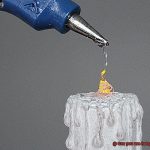Are you looking to upgrade your bathroom with a new vanity top? But the question that might be bugging you is, how do you attach it securely? Fret not, because we’re here to help. One of the most common queries during the installation process is whether silicone can be used to attach the vanity top. In this post, we’ll walk you through the answer and guide you on using silicone for a secure attachment.
Choosing the right adhesive for attaching a vanity top can be overwhelming. With so many options available in the market, it’s natural to feel confused. However, silicone stands out as a popular choice due to its flexibility and sturdy adhesion. It’s perfect for bonding non-porous materials like vanity tops.
We’ll delve into the benefits of using silicone for attaching your vanity top and provide step-by-step instructions on how to apply it. We’ll also highlight some important tips that will ensure a long-lasting and secure installation of your vanity top.
So, if you want to learn about using silicone as an adhesive for your new bathroom vanity top, read on. We’ve got all the information you need right here in this blog post.
What is Silicone?
Contents
- 1 What is Silicone?
- 2 Benefits of Using Silicone for Vanity Top Attachment
- 3 Drawbacks of Using Silicone for Vanity Top Attachment
- 4 Tips for Applying Silicone Adhesive
- 5 Potential Issues with Silicone Adhesive
- 6 Alternatives to Using Silicone for Vanity Top Attachment
- 7 Professional Installation Considerations
- 8 Conclusion
Silicone is a synthetic material that defies limits. It has become a ubiquitous component in various applications, from sealants to adhesives and caulks. This versatile material is a type of elastomer, meaning it can be stretched and then return to its original shape. Silicone is made from silicon, oxygen, carbon, and hydrogen – all readily available and non-toxic materials that make it a safe option for different uses.
What makes silicone stand out is its unique properties that make it an excellent choice for different environments and situations. It is highly resistant to heat and cold, making it ideal for use in extreme temperatures. Its waterproof and chemical-resistant nature also make it an outstanding option for use in environments where exposure to liquids or chemicals is likely. Additionally, silicone is flexible, making it beneficial when attaching surfaces that may expand or contract due to temperature changes.
Silicone comes in different forms, including sealants, adhesives, and caulks. Each of these forms has specific properties that make them suitable for different applications. For example, silicone sealants are designed to create a watertight seal between two surfaces, while silicone adhesives are used to bond two surfaces together permanently.
One of the most common applications of silicone is as an adhesive to attach a vanity top. However, while silicone is easy to apply and provides a strong bond, there are limitations and potential drawbacks to using it as an adhesive.
One concern with using silicone as an adhesive for a vanity top is the possibility of the top shifting or moving over time due to an inadequate bond or the weight of the top causing it to gradually shift. Additionally, if the silicone adhesive is not applied evenly, gaps between the vanity top and the base cabinet may occur, leading to water damage or other issues.
Another consideration when using silicone as an adhesive for a vanity top is the difficulty in removing the top if needed. Silicone creates a strong bond that makes it challenging to remove the vanity top without causing damage to either the top or the base cabinet, which can be problematic if you need to replace the vanity top in the future.
Benefits of Using Silicone for Vanity Top Attachment
Designing the perfect bathroom is no easy feat, but once you’ve found the ideal vanity top, you want to ensure it stays secure for years to come. Fortunately, using silicone for vanity top attachment offers a plethora of benefits that make it a top choice for homeowners.
Flexibility is a key advantage of using silicone to attach your vanity top. This material can absorb any movement or vibrations that may occur, preventing damage or cracking to the countertop or walls. This means you can have peace of mind knowing your vanity top will stay secure without causing any damage.
Another significant benefit of silicone is its waterproof properties. Bathrooms are high-moisture areas, and traditional adhesives may break down over time when exposed to water. However, silicone can withstand constant exposure to moisture without losing its adhesion properties. This eliminates the risk of your vanity top becoming loose or falling off.
In addition to its flexibility and waterproof properties, silicone is also easy to apply and remove without causing any damage. This is particularly important in case repairs need to be made or if the vanity top needs replacing in the future. Unlike traditional adhesives that may leave behind stubborn residue or cause damage when trying to remove them, silicone can be easily removed without causing any harm.
To ensure a secure and long-lasting attachment, it’s important to follow proper installation techniques when using silicone. But with its numerous benefits, it’s no surprise that more and more homeowners are turning to silicone as their go-to adhesive for vanity tops.
![]()
Drawbacks of Using Silicone for Vanity Top Attachment
When it comes to attaching vanity tops, silicone adhesive may seem like the perfect solution. However, even superheroes have their weaknesses, and silicone is no exception. As an expert in this topic, I’ve compiled some research notes to help you understand the potential drawbacks of using silicone for your vanity top attachment needs.
One of the most significant drawbacks of using silicone is its difficulty to remove. Although it creates a strong bond between the vanity top and base, it can be challenging to break if you need to replace or repair your top. This could result in a frustrating and time-consuming process that could have been avoided with a different adhesive.
![]()
Another issue with silicone is its inability to provide enough support for heavier vanity tops. If you have a particularly weighty top, it might require a stronger adhesive or mechanical fasteners to ensure that it stays securely in place. Silicone may not be able to handle the weight of the top, leading to instability and potential damage.
On top of these concerns, silicone can also be messy and difficult to work with, especially for those who are inexperienced with adhesives. Even the slightest mistake during application could create gaps or air pockets that weaken the bond between the vanity top and base.
Finally, while silicone is durable and long-lasting, it’s not permanent and may require periodic reapplication to maintain its strength and effectiveness. This requirement can be inconvenient for homeowners looking for a low-maintenance option for their vanity top attachment needs.
Tips for Applying Silicone Adhesive
When it comes to installing a new vanity top, using silicone adhesive is a popular choice due to its strong bonding capabilities and water-resistant properties. However, applying the adhesive correctly is crucial for a successful installation. Here are some tips for applying silicone adhesive when attaching a vanity top:
Choosing the Right Silicone Adhesive
Not all silicone adhesives are created equal. It’s important to choose a product specifically designed for use in bathrooms or kitchens, as these will be more resistant to moisture and humidity. Reading the manufacturer’s instructions can help you determine which product is best suited for your project.
![]()
Cleaning and Preparing the Surface
Before applying the silicone adhesive, it’s important to ensure that the surface is clean, dry, and free of any debris or residue. Use a mild cleanser and a soft cloth to wipe down the surface and allow it to dry completely before proceeding. Additionally, lightly sanding the surface can create a rough texture that will help the adhesive bond more effectively.
![]()
Using a Caulking Gun
Using a caulking gun can provide precision and control when applying silicone adhesive. Apply a thin, even layer of adhesive along the edges of the vanity top, leaving small gaps at regular intervals to allow for expansion and contraction. Be sure to work quickly, as silicone adhesive sets up fairly quickly.
Positioning the Vanity Top
Once the adhesive is applied, carefully position the vanity top onto the base cabinet or support structure. Using clamps or weights can help hold it in place while the adhesive cures. Allow the adhesive to dry for at least 24-48 hours depending on the product used before removing any clamps or weights.
Trimming Away Excess Silicone
Finally, once the adhesive is fully cured, use a sharp knife or razor blade to carefully trim away any excess silicone from around the edges of the vanity top. This will give your installation a clean and professional-looking finish.
Potential Issues with Silicone Adhesive
While it may seem like a convenient option, there are potential issues that need to be considered beforehand. As an expert in this area, I have researched and found some crucial points that you need to know.
Firstly, the weight and pressure of the vanity top can be a major concern when using silicone adhesive. If the vanity top is heavy or if there is consistent pressure applied to it, the adhesive may not be strong enough to hold it in place. The last thing you want is for your vanity top to fall off and cause damage or harm someone nearby.
Another issue with silicone adhesive is its resistance to moisture. Bathrooms are naturally moist environments, which means that any adhesive used in this space must be able to withstand these conditions. However, silicone adhesive can break down over time when exposed to moisture, causing the vanity top to become loose or detached.
In addition, removing silicone adhesive can be challenging if adjustments or repairs to the vanity top are needed. It may require significant effort and potentially damage the surface underneath.
To avoid these potential issues, consider other types of adhesives that are better suited for heavy or moist environments. Some alternatives include epoxy or construction adhesive.
![]()
Alternatives to Using Silicone for Vanity Top Attachment
First on the list is construction adhesive. This type of adhesive is specifically designed to bond materials such as stone, wood, and metal. It creates a strong and durable bond that can support the weight of your vanity top and any items you place on it. Plus, it’s moisture-resistant, making it a great choice for bathrooms where water damage can be a concern.
Another option to consider is epoxy. Epoxy is a two-part adhesive known for its strength and durability. It can bond a variety of materials, including stone and metal, and create a waterproof seal to protect against water damage. Although it may take longer to set than other adhesives, the added strength and durability that epoxy provides makes it worth the wait.
If you’re not keen on using adhesive altogether, mounting brackets are another alternative to consider. These brackets provide support for your vanity top without the need for adhesive. They can be attached to the wall or cabinet and then screwed into the underside of the vanity top. This method ensures that your vanity top stays securely in place without worrying about the adhesive weakening over time.
Professional Installation Considerations
Before you begin the installation process, there are a few crucial factors to consider to ensure a flawless and professional installation.
First and foremost, make sure that the surface where the vanity top will be installed is clean and dry. Dirt, debris, or moisture can impair the adhesive bond between the vanity top and cabinet. Hence, it is vital to take the time to thoroughly clean and dry the surface before proceeding with the installation.
The next step is to choose the right adhesive for the job. While silicone works well for sealing and caulking, it may not be strong enough to handle heavy or large vanity tops. It is advisable to use a construction adhesive specifically designed for bonding surfaces like wood, laminate, or stone.
Another critical consideration is the weight of your selected vanity top. Some materials and sizes can be quite heavy and require additional support. To ensure a stable installation, you may have to reinforce the cabinet with extra bracing or use a mounting system that evenly distributes the weight.
Lastly, always follow manufacturer instructions carefully. Different materials and adhesives may require specific tools or techniques, as well as sufficient curing time before using the vanity. It’s essential to adhere to these guidelines to ensure a secure and long-lasting attachment of your vanity top.
Yc8-Y0KyDRI” >
Conclusion
To sum it up, silicone adhesive is a go-to option for attaching vanity tops thanks to its flexibility, water-resistant properties, and easy application. Nevertheless, it’s crucial to weigh the cons such as challenging removal and inadequate support for heavier vanity tops. To ensure a secure attachment that lasts for years, proper installation techniques are essential.
Selecting the appropriate silicone adhesive designed explicitly for bathroom or kitchen use is vital. Preparing the surface by cleaning and sanding it can create a rough texture that enhances adhesion. A caulking gun provides precision and control during application, while clamps or weights can hold the vanity top in place while the adhesive cures.
If you’re worried about potential issues with silicone adhesive, alternatives like construction adhesive or mounting brackets may be worth considering. Additionally, take into account factors such as your selected vanity top’s weight and manufacturer instructions when installing it.
Overall, using silicone adhesive to attach your vanity top offers numerous benefits that make it an excellent choice for homeowners looking to upgrade their bathrooms.





